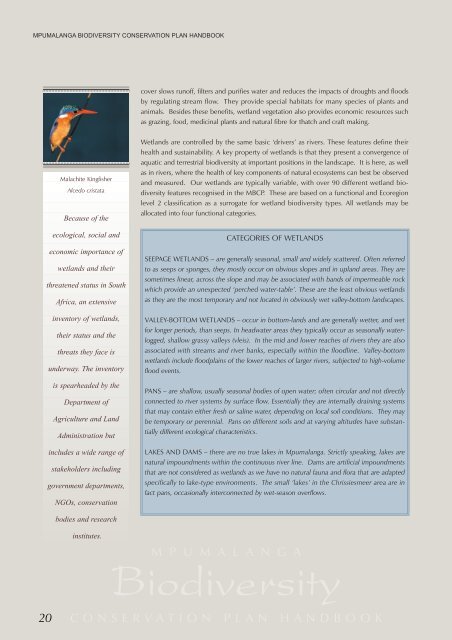Mpumalanga Biodiversity Conservation Plan Handbook - bgis-sanbi
Mpumalanga Biodiversity Conservation Plan Handbook - bgis-sanbi
Mpumalanga Biodiversity Conservation Plan Handbook - bgis-sanbi
Create successful ePaper yourself
Turn your PDF publications into a flip-book with our unique Google optimized e-Paper software.
MPUMALANGA BIODIVERSITY CONSERVATION PLAN HANDBOOK<br />
20<br />
Malachite Kingfisher<br />
Alcedo cristata<br />
Because of the<br />
ecological, social and<br />
economic importance of<br />
wetlands and their<br />
threatened status in South<br />
Africa, an extensive<br />
inventory of wetlands,<br />
their status and the<br />
threats they face is<br />
underway. The inventory<br />
is spearheaded by the<br />
Department of<br />
Agriculture and Land<br />
Administration but<br />
includes a wide range of<br />
stakeholders including<br />
government departments,<br />
NGOs, conservation<br />
bodies and research<br />
institutes.<br />
cover slows runoff, filters and purifies water and reduces the impacts of droughts and floods<br />
by regulating stream flow. They provide special habitats for many species of plants and<br />
animals. Besides these benefits, wetland vegetation also provides economic resources such<br />
as grazing, food, medicinal plants and natural fibre for thatch and craft making.<br />
Wetlands are controlled by the same basic ‘drivers’ as rivers. These features define their<br />
health and sustainability. A key property of wetlands is that they present a convergence of<br />
aquatic and terrestrial biodiversity at important positions in the landscape. It is here, as well<br />
as in rivers, where the health of key components of natural ecosystems can best be observed<br />
and measured. Our wetlands are typically variable, with over 90 different wetland biodiversity<br />
features recognised in the MBCP. These are based on a functional and Ecoregion<br />
level 2 classification as a surrogate for wetland biodiversity types. All wetlands may be<br />
allocated into four functional categories.<br />
CATEGORIES OF WETLANDS<br />
SEEPAGE WETLANDS – are generally seasonal, small and widely scattered. Often referred<br />
to as seeps or sponges, they mostly occur on obvious slopes and in upland areas. They are<br />
sometimes linear, across the slope and may be associated with bands of impermeable rock<br />
which provide an unexpected ‘perched water-table’. These are the least obvious wetlands<br />
as they are the most temporary and not located in obviously wet valley-bottom landscapes.<br />
VALLEY-BOTTOM WETLANDS – occur in bottom-lands and are generally wetter, and wet<br />
for longer periods, than seeps. In headwater areas they typically occur as seasonally waterlogged,<br />
shallow grassy valleys (vleis). In the mid and lower reaches of rivers they are also<br />
associated with streams and river banks, especially within the floodline. Valley-bottom<br />
wetlands include floodplains of the lower reaches of larger rivers, subjected to high-volume<br />
flood events.<br />
PANS – are shallow, usually seasonal bodies of open water; often circular and not directly<br />
connected to river systems by surface flow. Essentially they are internally draining systems<br />
that may contain either fresh or saline water, depending on local soil conditions. They may<br />
be temporary or perennial. Pans on different soils and at varying altitudes have substantially<br />
different ecological characteristics.<br />
LAKES AND DAMS – there are no true lakes in <strong>Mpumalanga</strong>. Strictly speaking, lakes are<br />
natural impoundments within the continuous river line. Dams are artificial impoundments<br />
that are not considered as wetlands as we have no natural fauna and flora that are adapted<br />
specifically to lake-type environments. The small ‘lakes’ in the Chrissiesmeer area are in<br />
fact pans, occasionally interconnected by wet-season overflows.<br />
M P U M A L A N G A<br />
<strong>Biodiversity</strong><br />
CONSERVATION PLAN HANDBOOK

















